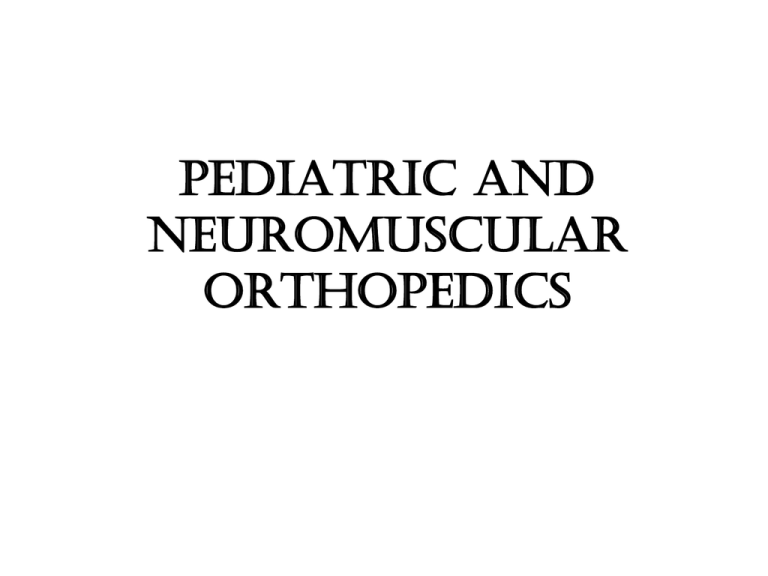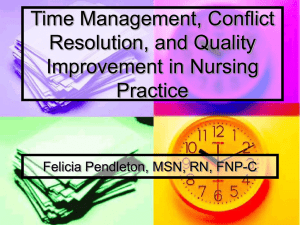Pediatric_and_Neuromuscular
advertisement

Pediatric and Neuromuscular Orthopedics Objectives • 11%-self-care-comfort -avoid complications • Identify signs and symptoms in selected pediatric and neuromuscular disorders. • Outline nursing interventions for medical and surgical protocols. • List strategies to maximize function in patients and families with neuromuscular disorders Development • • • • • Infancy 0-18 months Toddler 18 mos – 3 yrs Pre-school 3-5 yrs School age 6-12 yrs Adolescence 13 –19 Pediatric Differences • Visualization – ossification – ultrasound – X-ray • • • • Bone Thick periosteum Metaphyseal growth Re-modeling Nursing Intervention • Nursing see Table 11-1 from Core Curriculum 4th ed. • Child’s developmental level • Parent and child’s ability to learn • Amount disorder interferes with: – ADLs – Growth – Learning Ability – Social Adjustment Nursing Intervention Parents • Realistic expectations • Understanding of the disease/disorder • Follow-up with treatment • Response to public inquiry Nursing Intervention • Team approach – Include child in decisions • Play – Independence, socialization, – Creativity, problem solving Upper Extremity Disorders • Congenital anomalies • Syndactyly webbing 2+ digits • Polydactyly extra digits • Congenital amputations /deficiencies • Brachial plexus injuries Lower Extremity Disorders • DDH • Legg-Calvé-Perthes • Intoeing, torsional problems • SCFE (presentations) • Limb length inequality • Osteomyelitis, septic joint • Trauma Developmental Dislocation of the Hip • • • • DDH F>M 1:500-1000 births Breech, 1st born Family history Developmental Dislocation of the Hip • Physical Exam - hip clicks and clunks • Barlow’s – push hip out back • Ortolani’s abduct click in • Decreased abduct • Unequal skin folds • Ultrasound - X-ray DDH Rx • Pavlik, abd. splint • Traction Bryant’s/ mod Bryant's • Surgical reduction closed vs open • Spica cast DDH Nursing Care • Traction • Neurovascular Exam – Amputation 2° necrosis • Cast syndrome • Can be fatal Talipes Equinovarus • “Clubbed Foot” 1.24:1000 births • M 2x > F • Inversion adduction and equinus of the forefoot • Fixed rigid deformity • Etiology: controversial • Uterine position • Idiopathic Talipes Equinovarus • Dx: clinical apparent • Calf smaller, Achilles short • Rx:Stretching • Casting • Surgical releases Talipes Equinovarus • Nursing, watch toes in cast • Foot will be smaller! • Rocker bottom from push up on metatarsals • Can play sports Intoeing • Most common complaint! • Metatarsus adductus (foot deformity) • Tibial torsion • Femoral anteversion Metatarsus Adductus • Foot deformity – 1:1000 births – Dx: exam – Rx: stretching • long leg molded cast • surgery Tibial Torsion • Physiologic bowing of tibia • 2º intrauterine position • NORMAL for toddler • No treatment unless present at 8 years of age • Nursing - bring grandparent to appointment Femoral Anteversion • Curvature of the femur • After 3 yrs resolves by 8yrs • Brace not effective • Osteotomy if functional problems after 8 yrs Va us cubitus valgus cubitus varus coxa vara heel varus genu varum metatarsus varus coxa valga heel valgus genu valgum hallux valgus Genu Valgus • Knock knees • Joint laxity -medial collateral ligs. • Common: 3 - 5 years • improves by 7 years • normal angulation • girls: 7 - 9° valgus • boys: 4 - 6° valgus Genu Varus • ^ dist between knees >2.5 cm • W/ ankles together • external torsion of femur • improves spontaneously by 18 - 24 mos in early amb & heavy children Blount’s Disease • X-ray changes medial prox tibia • 50% unilat. tibial bowing • ^Black, ^obese, • Rx: no Δ 6 mos bracing • Surgical >30 mos old w/o Rx or structural / functional deform Blount’s Disease • Rx: • Corrective prox. osteotomy. • Hemiepiphysiodesis • External fixator – Some with gradual correction Osteogenesis Imperfecta “OI” • Brittle bone disease fracture with minimal stress • Multiple types some fatal • Etiology: autosomal dominant vs. recessive • Defect collagen synthesis • 1:20,000 births Osteogenesis Imperfecta “OI” • Dx: Clinical deformities • Blue sclera, shepherds crook deformity • Dentinogenesis, deafness • Radiographs • Biopsy • Bone density Osteogenesis Imperfecta “OI” • Rx brief Light wt. immob • I-M rods “Bailey” grows with child • Pamidronate treatment • Pain meds. • “Brittle baby” NO BP’s signs Don’t pull limbs, • Physical NOT mental handicap • Encourage independence Legg Calvé Perthes • • • • Aseptic necrosis femoral head Idiopathic vs heredity M 4x >F 1:2000 births Age 3-12 years Legg Calvé Perthes • Sx: Knee, hip, thigh pain • Limp • Decreased ROM • Dx: exam / X-ray Slipped Capital Femoral Epiphysis • • • • • • Endocrine/ obesity/ growth / trauma F 8-15yrs. M 10-17yrs 1 : 10,000 adolescents Sx: Hip, knee, pain (long duration) Limp, decreased ROM Dx: Hallmark sign- lack of internal rotation X-ray -“Ice cream falling off the cone Slipped Capital Femoral Epiphysis • • • • Rx: bedrest, N W B, crutches Surgical pinning Teach S&S for other hip - >50% Limb Length Inequality • Congenital vs acquired • Sx: short limb, limp, back pain • Dx: X-ray, CT, bone age Limb Length Inequality Rx: • < 2cm no treatment • 2-6 cm lifts epiphysiodesis • >6 - 15cm shorten opposite limb • Limb lengthening, external fixation Limb Length Inequality • • • • Nursing Pain management Pin care Compartment syndrome • Emotional support Osgood-Schlatter’s Disease • F 8-13 yrs M 1115 yrs • Sx: painful swelling tibial tubercle • cosmetic deformity Osgood-Schlatter’s Disease • Dx: exam • X-ray traction apophysitis • Rx: rest, ice, stretch hamstrings • Casting Trauma • Leading cause of death in children • Common injuries (see table 11-3 ) • Child abuse – Battered Child Syndrome Trauma: Child Abuse • • • • 3.14 million children reported abused Physical abuse Greatest < 3 years (66-78%) 30% under 6 mos Salter-Harris Classification 1 2 3 4 5 Child Abuse - Fractures • Most common presentation! • >30% under 3 mos. • 70% under 6 mos.(1yr) are inflicted Common Fractures Inflicted • Metaphyseal • Rib Fxs seen in 5-20% of abused • Scapular/distal clavicle/ night stick • Vertebral fx. or subluxation Common Fractures Inflicted • Finger Fx. In nonambulating child • Humerus Fx. (X supracondylar) < 3 Yrs. • Bilateral, multiple, or Fxs in different stages of healing • Complex skull Fx Fracture treatment Questions Linsey, 5 months old presents with knee swelling which of the following would prompt you to file for suspected child abuse: A. Septic joint with staph on aspiration B. Mongolian spots about the lower back C. Metaphyseal fractures of the distal femur D. Parent are obviously worried and seem really nice. Questions Three year old Stephanie has a history on limping and refusing to put weight on her left leg. She is lying with her leg externally rotated. You are admitting her for: A. Traction to treat her Perthes disease and high fever. B. Observation for bracing of her septic hip. C. fever, high white count Perthes treatment. D. Severe malaise, fever, pre-op for septic hip aspiration. Questions An 18 month old infant is admitted to your unit with a fractured femur. You notice blue sclera and shepherd crook deformities of his arms. You would: A. Hang “Brittle Baby” sign on his crib B. Change his diapers lifting him by the feet C. Keep his medication strictly by weight even if ineffective to prevent overdosing. D. Use real plasters for casting. Achondroplasia • Most common dwarfing syndrome • 1 of every 26,000 live births M>F • Etiology: abnormal endochondral ossification • genetic defect autosomal dominant – 90% spontaneous mutations Achondroplasia • Hypotonia resulting in slow motor development • C-spine injuries secondary to poor head control • Low back pain 2° to spinal stenosis • Thoracolumbar kyphosis hyperlordosis • longitudinal growth most affected • difficulty performing ADL’s Scoliosis • Lateral curvature of the spine • Congenital • Paralytic • Neuromuscular • Idiopathic = most common Idiopathic Scoliosis • • • • M=F, Rx 10x more 3% teens screened Rx - <20° none 20-40° brace - to prevent further curvature • >40 PSF sequential fixation w/graft Questions Your neighbor says her 13 year old daughter has scoliosis and the brace is not making it better she might need surgery. You know: A. She would improve the curve if she wore the brace. B. Her curve must be close to 40°,and bracing dose not make it better. C. Surgery should be performed to make her back completely straight. D. She will have osteoporosis if it is not fixed immediately. Neuromuscular Disorders • Nursing see Table 2 Core Curriculum 3rd ed. • Level of knowledge of the disease – Realistic expectations – Activities with-in patient limits • • • • Psychological & functional levels Support systems Bowel/bladder function Skin, Nutrition, Immobility Neuromuscular Disorders • • • • • Fatigue Communication Intellectual stimulation Dressing Emotional needs Neuromuscular Disorders • Non Progressive – Cerebral Palsy – Myelodysplasia- Spina Bifida – Arthrogryposis Cerebral Palsy - CP • Motor disorder following anoxia to cerebral cortex • Single largest disability in children • 1-5:1,000 • Time of occurrence – Prenatal 80% – Perinatal 5% – Postnatal 15% Cerebral Palsy- CP • Dx: • Spastic quadriplegia – cortical motor tract • Athetotic – extrapyramidal tract • Ataxic – cerebellum /balance disturb • Rigid - mixed Cerebral Palsy- CP • Nursing • Parental education non progressive • Mainstream as much as possible • Grieve loss of typical child Myelodysplasia - Spina Bifida • Group of malformations of spine/post. laminae of vertebra fail to close • Occulta 20-25% all births – some with no symptoms • Cystica - Sac – Meningocele – meningeal sac – Myelomeningocele – spinal cord too! • Has neuro deficits distal to lesion • Hydrocephalus 90% Myelodysplasia - Spina Bifida • F > M 1: 1,000 births • Etiology: genetic, folic acid, valproic acid • Dx: clinical exam, X-ray, MRI • Rx: neuro, ortho, urologic • Wide range of symptoms Myelodysplasia- Spina Bifida • Nursing – multi-disciplinary team • Promote mobility, ADLs, diet, • Bowel bladder program • Latex precautions • Neuro status – shunt problems • Insensate skin, water temp, braces • Multiple ortho corrections Arthrogryposis • Non-progressive disorder with multiple congenitally rigid joints • Etiology: unknown 0.03% general population • Dx: clinical exam X-ray, muscle bx. Arthrogryposis • Rx: Aggressive PT at birth • Casting, bracing, surgical releases • Normal intelligence Progressive – Muscular Dystrophy – Neurofibromatosis – Peroneal Muscular Atrophy – Friedrich’s Ataxia – Polio Muscular Dystrophy - Myopathy • Progressive hereditary degenerative weakness of skeletal muscles • 2-3 of 10,000 males • DX: Muscle Bx. ^ CPK abnormal EMG • Gower’s sign –climb up legs w/ hands • Many types Duchenne’s most common & severe < 20 yr life span • Becker’s seen at 7yrs < 40 yr life span Muscular Dystrophy • Nursing • Depression – frustration guilt • Respiratory - cardiac complications • Malignant hyperthermia Neurofibromatosis • Von Recklinghausen’s disease • Progressive • Tumors in central and peripheral nervous system • 1:400,000 births M=F , 4 Stages • Dx: café au lait spots >6 • Lisch nodules in iris Neurofibromatosis • • • • Instigated by puberty Spinal deformities 10-15% Scoliosis, pseudoarthrosis Most common predisposition to cancer for children • Elephantitis • Nursing - genetic counseling • Multi system effected (See table 13 Core Curriculum) Questions The single largest cause of disability in children is A. Neurofibromatosis B. Myelodysplasia C. Arthrogryposis D. Cerebral Palsy Questions John is 11 year old pubertal male. He is being seen today for scoliosis screening you notice has 6 large light brown spots on his trunk. You worry that he is in stage A. 4 of neurofibromatosis B. 2 of myasthenia gravis C. 2 of Von Recklinghausen’s disease D. 5 of osteogenesis imperfecta Peroneal Muscular Atrophy • Charcot-Marie-Tooth – hereditary atrophy of peripheral and motor nerve roots & freq spinal cord • Etiol: unknown 2-5 100,000 people M>F • Dx: decrease sensation / function • Rx: orthotics – surgical releases • Genetic counseling Friedrich’s Ataxia • Hereditary degeneration of the spinal cord and cerebellum • M=F presents 5-20 yrs. • Dx: unsteady gait (ataxia) 1st symptom • Aggravated by puberty <40 yr life span • Fibromyopathic changes heart muscle Polio • Acute infection of nervous system by polio virus • Incidence rising due to immunization refusal by parents • Sx: fever malaise, muscle pain, paralysis, some recover 4 mos-2yrs • Rx: symptomatic post polio 20yrs • Immunizations Thank-you!








